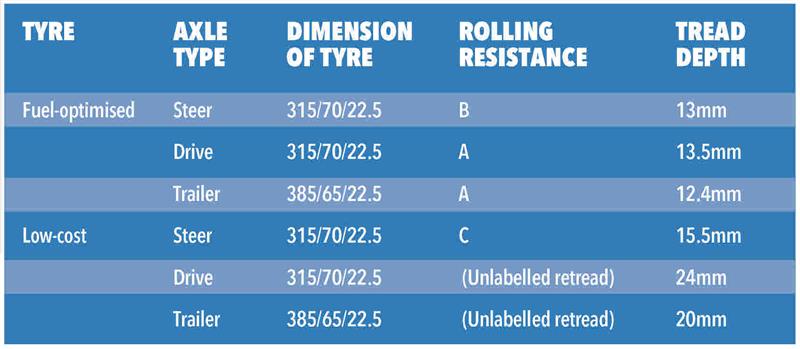Budget tyres are designed with hard-wearing rubber compounds and deep tread for maximum longevity, reducing the number of replacements required, so generating a low pence-per-kilometre (PPK) rate, according to logistics consultancy Dynamon. However, it argues that these tyres significantly increase vehicle fuel consumption and, in many cases, can raise total the total vehicle running costs.
To compare the fuel consumption of a tyre policy optimised for low cost to a tyre policy optimised for fuel performance, Dynamon ran tests on tractor and tridem trailer tyres at Millbrook Proving Ground in July 2018. A Scania 4x2 G410LxA MNA (2017) tractor towed a 4.2m-high refrigerated trailer loaded to about 70% of capacity at a constant 50mph.
Low-fuel tyres were tested on the first day; low-cost tyres the second. During these trials, an identical control truck fitted with a single set of tyres shadowed the trial rig. To cancel out differing track conditions – and the wind picked up on the second day – results were modified (‘normalised’) by factoring in fuel performance variations between the runs of the control truck.
Dynamon chose three different journeys, in tests lasting 30, 90 and 180 minutes. In the case of the longest trial, the fuel-optimised tyres offered a 17% fuel saving over the low-cost tyres (the 90-minute test had similar results). According to Dynamon, this was because they ran cooler: the main contributor to a tyre’s rolling resistance is its deformation and reshaping as it rolls. The movement of the rubber compound generates heat through internal friction. Energy loss due to this heat generation must be overcome by the vehicle’s engine, resulting in wasted fuel. Marked differences in tyre temperature were recorded (above).
During the 30-minute test, a slightly larger fuel-saving disparity, of 18.4%, was observed between the tyre types. Dynamon suggests that this is because the low-fuel tyres approach their optimum temperature faster than the low-cost tyres.

In conclusion, to identify a tyre policy that achieves minimum total cost of ownership, fleets must consider the cost of tyres, their real-world fuel performance, and the cost of fuel. Dynamon warns that this test only measured the tyres’ fuel performance at constant speed, elevation, and at full tread depth (tyres were new, but had been broken in). The full picture would also need to take in the vehicles’ drive cycle and lifetime tyre performance – a service that Dynamon is now offering.